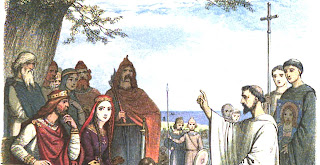Pope Honorius III took a special interest in the monastic orders. He approved the Dominicans in 1216, the Franciscans in 1223, and the Carmelites in 1226. It was his idea that the various abbeys and priories with Benedictine monastic communities in England be united. The first General Chapter of this united congregation was held in Oxford in 1218. The origins of Benedictines in England go back much further than the 13th century, however, thanks principally to three individuals.
Augustine of Canterbury's arrival in England at the tail end of the 6th century CE was the start of the first great wave of Christianizing on that island. He was created the first Archbishop of Canterbury and had an enormous impact on bringing Christianity to several kingdoms, along with founding monasteries.
Immediately following Augustine was Wilfrid (c.633 - 709/710), a Northumbrian noble who entered the religious life as a teenager and became the first abbot of a monastery in Ripon dedicated to St. Peter. He later became bishop of York (York did not become an archbishopric until 735 with Paulinus). Wilfrid was the spokesman for Roman Christianity (as opposed to Celtic Christianity) at the Synod of Whitby in 664. His arguments on how the date of Easter should be calculated each year won over the Celtic St. Cuthbert.
The third highly influential figure in the early origins of English Christianity and monasticism was Benedict Biscop (c. 628 – 690). He founded the monastery at Jarrow, where among other influences he was the teacher of Bede. Benedict's given name was "Biscop Baducing"; he was not just a noble, he even served under King Oswiu of Bernicia before traveling to Rome and returning to England with enthusiasm for supporting the Church. On a second trip to Rome, Benedict met Wilfrid. Returning from this second trip, he stopped at an island off the coast of Provence, where a monastery was using the Rule of St. Benedict. He spent two years there, taking vows, learning the Rule, and adopting the name "Benedict." After a third trip to Rome, Pope Vitalian asked him to go back to England with Theodore of Tarsus. After doing so, Theodore appointed Benedict abbot at Canterbury.
The English Congregation now has about 20 houses (Ealing in London is shown above), with a few hundred monks and nuns spread across them.
We have a lot of info about Wilfrid based on those who knew him, especially Bede and a monk who wrote a biography of Wilfrid shortly after his death. I'd like to share some of his life story over the next two days.










